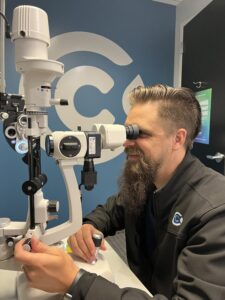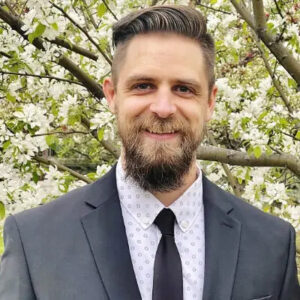
Dr. Holland in his clinic. Dr. Holland says that being intentional and strategic in how he schedules patients has made a huge difference to patient experience and practice profitability.
A change to how you do exams that helps patients and bolsters per-patient revenue.
By Zachary Holland, OD, FSLS
Dec. 6, 2023
Sometimes it’s worth making the effort to alter how you do things during exams. In my practice, I found that scheduling time for consults during exams has greatly improved my patient’s education of our services, and, consequently, our profitability.
Rethinking How Consults Happen
I don’t do dry eye, myopia control, or any type of consults, on existing patients within my practice any more. I only do consult appointments for patients referred directly to me for a specific problem.
This strategy is going to deviate significantly from what many ODs do and what many practice management experts recommend. But I have my reasons; and it’s working at my clinic at least. I try to set up many of my processes to maximize long-term efficiency, minimizing no-shows and maximizing patient information for future treatments.
I personally just haven’t had luck scheduling a routine care patient to come back to discuss their myopia control or dry eye or scleral lens candidacy. I have found that if the patient gets a whiff of “that sounds expensive,” and has the ability to say “no” to something before they understand what they are saying “no” to, I have lost the battle already.
In an attempt to combat what I call premature disinterest, I schedule all comprehensive appointments for 45 minutes (tech + doctor time). I have the ability to easily do a 20-30 minute exam and then discuss and answer any questions the patient may have about their candidacy for specialty care. To be transparent, my practice is already rampant with specialty eyecare, so I am not extending 20+ appointments daily. I probably do 12 comprehensive exams per day in addition to 10-12 shorter medical or contact lens follow-up visits daily.
How Do I Make this Change?
You are going to have to totally reprogram both your brain and patient care schedule to maximize revenue per patient. I understand that it is going to be extremely difficult to reduce your patient exam count by 30-40 percent per day. If you want to practice specialty care, you’ll need to make some concessions. And seeing a routine patient care exam every 20 minutes is definitely one of them. Maybe start with one half day per week where appointments are scheduled for 10-20 minutes longer than normal in an attempt to not totally upend the whole system you have built at your office.
I have gradually revamped this system since purchasing my practice in 2020. But it was effectively in place prior to my ownership and I am just expanding on the established system. Will some appointments end early due to lack of specialty candidacy? Of course, but some will not and those are the appointments that you want to capitalize on and retain yearly.
Any Downside or Cost to Making this Change?
The potential downside is lower revenue per hour if you don’t change anything other than elongate your scheduled appointments. But if you can capitalize and double or triple your revenue per patient, you will be happier and change more lives.
It’s a different conversation when patients come in for a routine exam and glasses, but leave with information on scleral lenses or myopia control. You need to create value during the appointment. If you can add that value in an extra 10 minutes instead of having the patient come back for a 30-minute pointed consultation, you have been much more efficient with both your patient’s time and your own.
Do you miss out on an 9921x co-pay for the consult/office visit? Yes. But remember, we don’t care about the $20 co-pay or $90 deductible payment. We want services that generate well over $1,000 per comp exam. Generally, once patients are on your myopia control, dry eye or specialty lens program, it’s a rinse and repeat situation next year. So, expanding revenue isn’t a linear, but exponential, growth curve.
Other Articles to Explore
The Upside
In our office, a higher specialty service capture rate has been realized because higher patient education has been made possible. It is not uncommon that I discuss the anterior segment photos/meibography of patients with dry eye disease during their routine exam.
This allows visualization of a disease the patient didn’t even know they had. This wouldn’t be possible if I was only doing 20-minute exams. By increasing exam time by 50-100 percent, you can increase your revenue per exam from the normal $35-450 to north of $1,200. My revenue per exam has exceeded $1,800 some months recently.
ROI
My revenue per patient is regularly between $1,200-$1,800/comprehensive exam.
Elongating the clinical examination would be a major culture change for most ODs. And while on its surface it appears inefficient, it actually leads to a much more educated patient population. Imagine if you could educate all of your patients on dry eye and myopia control this year, and they all declined. Then next year they all had mild progressive symptoms. How high would your capture rate be if each of your patients came to you and said, “Doctor, remember last year you discussed IPL with me? Am I still a candidate? My dry eye isn’t getting any better with the artificial tears I am using”?
Getting Closer to a Long-Term Practice Goal
I wanted to create and expand a specialty practice. It is my goal one day to eliminate primary care from my practice. While this has its hurdles in capturing routine care disease treatments, I am working toward practicing specialty and referral care only.
In 2022, glasses sales represented 4 percent of my gross revenue collected in my $2,000,000 single-OD practice.
Point of clarification: When I discuss “revenue per patient” I am discussing “collections paid by insurance or cash paid by the patient” and NOT billed services.
 Zachary Holland, OD, FSLS, is the owner of Cornea & Contact Lens Institute of Minnesota. To contact him: drholland@corneaandcontactlensinstitute.com
Zachary Holland, OD, FSLS, is the owner of Cornea & Contact Lens Institute of Minnesota. To contact him: drholland@corneaandcontactlensinstitute.com

























